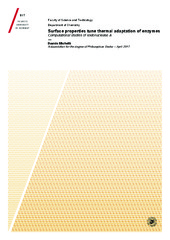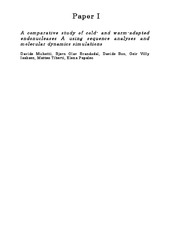| dc.contributor.advisor | Brandsdal, Bjørn Olav | |
| dc.contributor.author | Michetti, Davide | |
| dc.date.accessioned | 2017-06-15T11:41:53Z | |
| dc.date.available | 2017-06-15T11:41:53Z | |
| dc.date.issued | 2017-04-26 | |
| dc.description.abstract | The endonucleases A from Aliivibrio salmonicida (VsEndA, cold-adapted) and Vibrio cholerae (VcEndA, warm-adapted) have been studied in this work. The goal was to compare these two systems, in order to find structural differences that could explain the mechanism of cold adaptation in the psychrophilic EndA. These two enzymes have previously been studied experimentally and the crystal structures have been solved. We first employed Molecular Dynamics (MD) simulations to characterize and compare the dynamical behavior of the two homologs and the underlying interaction network. RMSF analysis did not show a significant increase in the flexibility of VsEndA compared to VcEndA and the active sites have similar mobility, contrary to general findings and assumptions in previous cold adaptation studies. There are, however, few regions with slightly increased RMSF values in both enzymes and in particular the psychrophilic C-terminal displays higher flexibility than the mesophilic one. Protein structure network (PSN) analysis revealed two clusters of ion-pairs in this region of VcEndA (E179-R222-E226 and D210-R225-E214). MD simulations of VsEndA incorporating the R222 salt-bridge network, display a decrease of the C-terminal RMSF compared to the wild-type (WT) enzyme, suggesting a possible role in thermostability for this electrostatic cluster in the mesophilic variant. We furthermore aligned the sequences of VsEndA and VcEndA together with other homologs from different thermal environments, in order to pinpoint amino acid substitutions shared only by psychrophilic enzymes. The amino acid substitutions T120V, S141I and A166S emerged from these studies as potential important mutations for temperature adaptation.
In order to develop an Empirical Valence Bond (EVB) model to evaluate reaction thermodynamics, a clear understanding of the reaction mechanism and the conformations of the different states of the EndA reaction is fundamental. In this respect, we first carried out Quantum Mechanical (QM) studies of the enzymatic reaction, computing the relevant energetics. Our calculations confirmed a concerted mechanism. Subsequent EVB calculations of the reaction in VcEndA gave activation free energies consistent with experimental data. In silico calculations of Arrhenius plot by EVB simulations reproduced the activation parameters for the reaction of VsEndA and VcEndA, displaying the characteristic trends in activation enthalpy (∆H‡) and entropy (∆S‡) for cold adaptation. Furthermore, the lower ∆H‡ in the psychrophilic enzyme was reflected in a lower internal energy change of the system along the reaction for the regions outside the active site. This observation was further tested in our EVB simulations by gradually imposing positional restraints on the outer parts of VsEndA structure and increasing in this way the rigidity of these regions. A lower surface mobility could, indeed, transform the psychrophilic enzyme activation parameters to resemble those of the mesophilic counterpart. We subsequently assessed with EVB the effect of mutations on the reaction catalyzed by VsEndA/VcEndA. The EVB models for the EndA homologs estimated an effect on activation parameters for the mutation S141I, located on the enzyme surface (previously identified by multiple sequence alignment). Altogether these data suggest that surface properties enable VsEndA to adapt to low temperatures. | en_US |
| dc.description.doctoraltype | ph.d. | en_US |
| dc.description.popularabstract | Cold-adapted enzymes (CAEs or psychrophiles) display stunning properties thanks to adaptation to low temperature environments (< 15 ˚C). In particular, the lower thermostability and higher specific activity compared to warm-adapted (or mesophilic) homologs have attracted the interest of researchers and industries. In the case of basic research, this class of enzymes is an exciting model for studying the relationship between enzyme structure and activity/stability. Different structural and sequence hypotheses have been suggested to account for enzyme cold adaptation, but still a clear picture is lacking despite decades of studies in the field. However, it has been shown that psychrophilic reactions are less dependent on temperature through lower activation enthalpies.
In my PhD project I have studied the endonucleases A from Aliivibrio salmonicida (VsEndA, cold-adapted) and Vibrio cholerae (VcEndA, warm-adapted). The goal was to compare these two systems, in order to find structural differences that could explain the mechanism of cold adaptation in the psychrophilic EndA. These two enzymes have previously been studied experimentally and the crystal structures have been solved. We first employed Molecular Dynamics (MD) simulations to characterize and compare the dynamical behavior of the two homologs and the underlying interaction network. RMSF analysis did not show a significant increase in the flexibility of VsEndA compared to VcEndA and the active sites have similar mobility, contrary to general findings and assumptions in previous cold adaptation studies. There are, however, few regions with slightly increased RMSF values in both enzymes and in particular the psychrophilic C-terminal displays higher flexibility than the mesophilic one. Protein structure network (PSN) analysis revealed two clusters of ion-pairs in this region of VcEndA (E179-R222-E226 and D210-R225-E214). MD simulations of VsEndA incorporating the R222 salt-bridge network, display a decrease of the C-terminal RMSF compared to the wild-type (WT) enzyme, suggesting a possible role in thermostability for this electrostatic cluster in the mesophilic variant. We furthermore aligned the sequences of VsEndA and VcEndA together with other homologs from different thermal environments, in order to pinpoint amino acid substitutions shared only by psychrophilic enzymes. The amino acid substitutions T120V, S141I and A166S emerged from these studies as potential important mutations for temperature adaptation.
In order to develop an Empirical Valence Bond (EVB) model to evaluate reaction thermodynamics, a clear understanding of the reaction mechanism and the conformations of the different states of the EndA reaction is fundamental. In this respect, we first carried out Quantum Mechanical (QM) studies of the enzymatic reaction, computing the relevant energetics. Our calculations confirmed a concerted mechanism. Subsequent EVB calculations of the reaction in VcEndA gave activation free energies consistent with experimental data. In silico calculations of Arrhenius plot by EVB simulations reproduced the activation parameters for the reaction of VsEndA and VcEndA, displaying the characteristic trends in activation enthalpy (∆H‡) and entropy (∆S‡) for cold adaptation. Furthermore, the lower ∆H‡ in the psychrophilic enzyme was reflected in a lower internal energy change of the system along the reaction for the regions outside the active site. This observation was further tested in our EVB simulations by gradually imposing positional restraints on the outer parts of VsEndA structure and increasing in this way the rigidity of these regions. A lower surface mobility could, indeed, transform the psychrophilic enzyme activation parameters to resemble those of the mesophilic counterpart. We subsequently assessed with EVB the effect of mutations on the reaction catalyzed by VsEndA/VcEndA. The EVB models for the EndA homologs estimated an effect on activation parameters for the mutation S141I, located on the enzyme surface (previously identified by multiple sequence alignment). Altogether these data suggest that surface properties enable VsEndA to adapt to low temperatures. | en_US |
| dc.description.sponsorship | This work was supported by the Research Council of Norway through a Centre of Excellence Grant (Grant No. 179568/V30) | en_US |
| dc.description | The papers II and III of this thesis are not available in Munin.
<br><br>
II. Michetti, D., Morello, G. R., Isaksen, G. V., Brandsdal, B. O.: “An Empirical Valence Bond model for the reaction of the endonuclease A from Vibrio cholera”. (Manuscript).
<br><br>
III. Davide Michetti, D., Isaksen, G. V., Brandsdal. B. O.: “Enthalpy-entropy optimization to survive in the cold: A case study of endonuclease A”. (Manuscript). | en_US |
| dc.identifier.isbn | 978-82-8236-258-0 (trykt) og 978-82-8236-259-7 (pdf) | |
| dc.identifier.uri | https://hdl.handle.net/10037/11153 | |
| dc.language.iso | eng | en_US |
| dc.publisher | UiT Norges arktiske universitet | en_US |
| dc.publisher | UiT The Arctic University of Norway | en_US |
| dc.rights.accessRights | openAccess | en_US |
| dc.rights.holder | Copyright 2017 The Author(s) | |
| dc.rights.uri | https://creativecommons.org/licenses/by-nc-sa/3.0 | en_US |
| dc.rights | Attribution-NonCommercial-ShareAlike 3.0 Unported (CC BY-NC-SA 3.0) | en_US |
| dc.subject | Enzyme cold adaptation | en_US |
| dc.subject | Empirical Valence Bond | en_US |
| dc.subject | Enzyme Design | en_US |
| dc.subject | Enzyme catalysis | en_US |
| dc.subject | VDP::Matematikk og Naturvitenskap: 400::Basale biofag: 470::Biokjemi: 476 | en_US |
| dc.subject | VDP::Mathematics and natural science: 400::Basic biosciences: 470::Biochemistry: 476 | en_US |
| dc.title | Surface properties tune thermal adaptation of enzymes - Computational studies of endonuclease A | en_US |
| dc.type | Doctoral thesis | en_US |
| dc.type | Doktorgradsavhandling | en_US |


 English
English norsk
norsk

